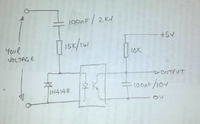p72
Member level 3
Hi All,
I am looking for help to design voltage level detector circuit. Not something specific project related.
How to detect different voltage level? Need to detect at two points, first is: between 20-30Vdc range and second between 80-300Vac. yes, one is dc and other is ac. Is it possible to detect voltage between ac and dc?
Is there any other method than voltage detector?
Thank you,
pj
I am looking for help to design voltage level detector circuit. Not something specific project related.
How to detect different voltage level? Need to detect at two points, first is: between 20-30Vdc range and second between 80-300Vac. yes, one is dc and other is ac. Is it possible to detect voltage between ac and dc?
Is there any other method than voltage detector?
Thank you,
pj


